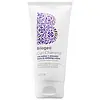What's inside
What's inside
 Key Ingredients
Key Ingredients

 Benefits
Benefits

 Concerns
Concerns

 Ingredients Side-by-side
Ingredients Side-by-side

Water
Skin ConditioningGlycerin
HumectantPolyquaternium-37
Isopropyl Myristate
EmollientPersea Gratissima Oil
Skin ConditioningGlycine Soja Oil
EmollientOryza Sativa Extract
AbsorbentHydrolyzed Quinoa
Skin ConditioningKeratin Amino Acids
Skin ConditioningLactobacillus/Tomato Fruit Ferment Extract
Skin ConditioningAloe Barbadensis Leaf Juice
Skin ConditioningTocopheryl Acetate
AntioxidantPanthenol
Skin ConditioningSorbitol
HumectantCitrus Aurantium Dulcis Peel Oil
MaskingCitrus Paradisi Peel Oil
MaskingAcyl Coenzyme A Desaturase
Skin ConditioningPropylene Glycol Dicaprylate/Dicaprate
EmollientHydrolyzed Corn Protein
Skin ConditioningHydrolyzed Wheat Protein
Skin ConditioningHydrolyzed Soy Protein
HumectantPPG-1 Trideceth-6
Skin ConditioningCetrimonium Chloride
AntimicrobialLeuconostoc/Radish Root Ferment Filtrate
AntimicrobialPolyquaternium-10
Sodium Hydroxide
BufferingPg-Hydroxyethylcellulose Cocodimonium Chloride
Parfum
MaskingDehydroacetic Acid
PreservativeBenzyl Alcohol
PerfumingWater, Glycerin, Polyquaternium-37, Isopropyl Myristate, Persea Gratissima Oil, Glycine Soja Oil, Oryza Sativa Extract, Hydrolyzed Quinoa, Keratin Amino Acids, Lactobacillus/Tomato Fruit Ferment Extract, Aloe Barbadensis Leaf Juice, Tocopheryl Acetate, Panthenol, Sorbitol, Citrus Aurantium Dulcis Peel Oil, Citrus Paradisi Peel Oil, Acyl Coenzyme A Desaturase, Propylene Glycol Dicaprylate/Dicaprate, Hydrolyzed Corn Protein, Hydrolyzed Wheat Protein, Hydrolyzed Soy Protein, PPG-1 Trideceth-6, Cetrimonium Chloride, Leuconostoc/Radish Root Ferment Filtrate, Polyquaternium-10, Sodium Hydroxide, Pg-Hydroxyethylcellulose Cocodimonium Chloride, Parfum, Dehydroacetic Acid, Benzyl Alcohol
Water
Skin ConditioningCetearyl Alcohol
EmollientBehentrimonium Chloride
PreservativeAmodimethicone
Parfum
MaskingIsopropyl Alcohol
SolventPhenoxyethanol
PreservativeBenzoic Acid
MaskingTrideceth-6
EmulsifyingHexyl Cinnamal
PerfumingTocopherol
AntioxidantOlea Europaea Fruit Oil
MaskingCamelina Sativa Seed Oil
Skin ConditioningPoly(Linseed Oil)
Butylene Glycol
HumectantLinalool
PerfumingPotassium Hydroxide
BufferingDilauryl Thiodipropionate
AntioxidantArginine
MaskingCetrimonium Chloride
AntimicrobialHelianthus Annuus Seed Extract
Skin ConditioningHydrolyzed Vegetable Protein Pg-Propyl Silanetriol
Skin ConditioningLimonene
Perfuming2-Oleamido-1,3-Octadecanediol
Skin ConditioningCitric Acid
BufferingBenzophenone-4
UV AbsorberCitronellol
PerfumingHaematococcus Pluvialis Extract
AntioxidantCI 14700
Cosmetic ColorantCaprylic/Capric Triglyceride
MaskingPotassium Sorbate
PreservativeCI 15510
Cosmetic ColorantWater, Cetearyl Alcohol, Behentrimonium Chloride, Amodimethicone, Parfum, Isopropyl Alcohol, Phenoxyethanol, Benzoic Acid, Trideceth-6, Hexyl Cinnamal, Tocopherol, Olea Europaea Fruit Oil, Camelina Sativa Seed Oil, Poly(Linseed Oil), Butylene Glycol, Linalool, Potassium Hydroxide, Dilauryl Thiodipropionate, Arginine, Cetrimonium Chloride, Helianthus Annuus Seed Extract, Hydrolyzed Vegetable Protein Pg-Propyl Silanetriol, Limonene, 2-Oleamido-1,3-Octadecanediol, Citric Acid, Benzophenone-4, Citronellol, Haematococcus Pluvialis Extract, CI 14700, Caprylic/Capric Triglyceride, Potassium Sorbate, CI 15510
 Reviews
Reviews

Ingredients Explained
These ingredients are found in both products.
Ingredients higher up in an ingredient list are typically present in a larger amount.
This ingredient is a preservative, antimicrobial, and emulsifier. It is often used in cosmetics for its ability to cleanse, condition, and reduce static.
Cetrimonium chloride is a quaternary ammonium salt, meaning it has a water-soluble structure.
Parfum is a catch-all term for an ingredient or more that is used to give a scent to products.
Also called "fragrance", this ingredient can be a blend of hundreds of chemicals or plant oils. This means every product with "fragrance" or "parfum" in the ingredients list is a different mixture.
For instance, Habanolide is a proprietary trade name for a specific aroma chemical. When used as a fragrance ingredient in cosmetics, most aroma chemicals fall under the broad labeling category of “FRAGRANCE” or “PARFUM” according to EU and US regulations.
The term 'parfum' or 'fragrance' is not regulated in many countries. In many cases, it is up to the brand to define this term.
For instance, many brands choose to label themselves as "fragrance-free" because they are not using synthetic fragrances. However, their products may still contain ingredients such as essential oils that are considered a fragrance by INCI standards.
One example is Calendula flower extract. Calendula is an essential oil that still imparts a scent or 'fragrance'.
Depending on the blend, the ingredients in the mixture can cause allergies and sensitivities on the skin. Some ingredients that are known EU allergens include linalool and citronellol.
Parfum can also be used to mask or cover an unpleasant scent.
The bottom line is: not all fragrances/parfum/ingredients are created equally. If you are worried about fragrances, we recommend taking a closer look at an ingredient. And of course, we always recommend speaking with a professional.
Learn more about ParfumWater. It's the most common cosmetic ingredient of all. You'll usually see it at the top of ingredient lists, meaning that it makes up the largest part of the product.
So why is it so popular? Water most often acts as a solvent - this means that it helps dissolve other ingredients into the formulation.
You'll also recognize water as that liquid we all need to stay alive. If you see this, drink a glass of water. Stay hydrated!
Learn more about Water